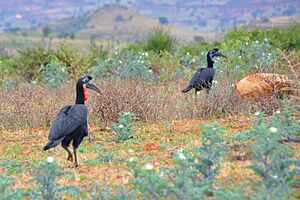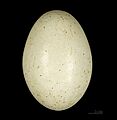Abyssinian ground hornbill facts for kids
Quick facts for kids Abyssinian ground hornbill |
|
|---|---|
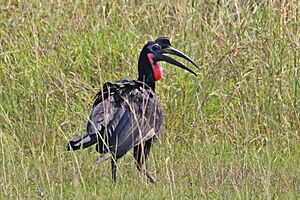 |
|
| male | |
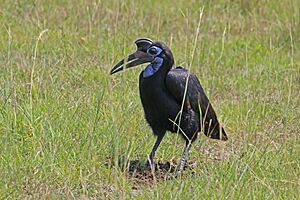 |
|
| female both at Semliki Wildlife Reserve, Uganda |
|
| Conservation status | |
| Scientific classification | |
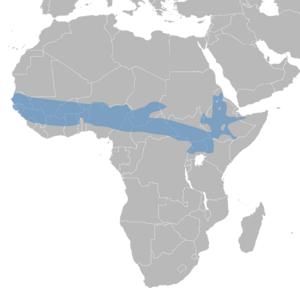 |
The Abyssinian ground hornbill is a large, unique bird from Africa. It's also called the northern ground hornbill. You can find it in areas north of the equator. It's one of two types of ground hornbills. This bird is the second biggest hornbill in Africa! Only the southern ground hornbill is a little larger.
Contents
About the Abyssinian Ground Hornbill
The Abyssinian ground hornbill's scientific name is Bucorvus abyssinicus. It was first described in 1780. Later, in 1783, a scientist named Pieter Boddaert gave it its scientific name. The name Bucorvus comes from the word Buceros, which is a group of Asian hornbills, and corvus, the Latin word for "raven." This bird is the only species in its group.
What Does It Look Like?
The Abyssinian ground hornbill is a big bird that lives on the ground. It has black feathers all over its body. When it flies, you can see its white wing feathers.
Male and Female Differences
Adult males have a patch of bare blue skin around their eyes. They also have a red patch of skin on their neck and throat. The very top of the throat patch is blue. Their beak is long and black, with a reddish part at the bottom. On top of the beak, there's a short, open black growth called a casque.
Females look similar but are smaller. All of their bare skin is dark blue. Young birds are dark brown. They have a smaller beak and a tiny casque. It takes about three years for young birds to grow their adult feathers and skin colors.
Size and Special Features
These birds are usually about 90 to 110 centimeters (35 to 43 inches) long. They can be around 110 centimeters (43 inches) tall. They weigh about 4 kilograms (8.8 pounds).
The Abyssinian ground hornbill has long feathers around its eyes. These feathers look like eyelashes. They help protect the bird's eyes from getting hurt.
Its Voice
This hornbill makes a deep, booming sound. It sounds like uh-uh, uh-uh-uh. You can hear this call from far away. They usually make this sound at dawn. Both the male and female birds sing together in duets.
Where Do They Live?
You can find the Abyssinian ground hornbill in northern parts of Africa. They live south of the Sahara Desert. Their range stretches from countries like Mauritania and Senegal in the west. It goes all the way east to Eritrea, Ethiopia, and parts of Kenya and Uganda.
They like open areas such as savannas and rocky places. They prefer areas with short plants. This helps them see and find food easily. They usually live in drier places than their relatives, the Southern ground hornbills. They need large trees to build their nests.
Some Abyssinian ground hornbills have been seen in Florida, USA. However, they are not breeding there naturally.
How Do They Live?
Abyssinian ground hornbills live in open grasslands. They usually live in pairs or small family groups. They walk around their territory to patrol it. They don't like to fly much. They usually only fly if they are scared. In zoos, these birds can live for 35 to 40 years.
What Do They Eat?
In the wild, they eat many different small animals. This includes tortoises, lizards, snakes, and spiders. They also eat beetles and caterpillars. Sometimes, they eat dead animals, fruits, seeds, and peanuts. They hunt during the day. Groups of these hornbills have large territories, from 2 to 100 square miles.
How Do They Breed?
The breeding season for Abyssinian ground hornbills changes depending on where they live. For example, in West Africa, they breed from June to August. In Kenya, they might breed as late as November.
They like to build their nests in large trees. They often choose baobab trees or palm stumps. The nest is built inside a hollow part of the tree. They have also been found nesting in rock holes or even man-made containers.
The female hornbill is partly sealed into the nest cavity. She uses a mix of mud and plants to do this. The male bird prepares the nest by lining it with dry leaves. The female then lays one or two eggs over about five days. She starts sitting on the first egg right away. This means the first chick to hatch gets a head start.
Incubation takes about 37 to 41 days. During this time, the male brings food to the female. The first chick grows very fast. The second chick usually doesn't survive. It often dies of starvation before it is four days old.
When the surviving chick is 21 to 33 days old, the mother leaves the nest. She then helps the male find food. The chick leaves the nest when it is 80 to 90 days old.
Abyssinian ground hornbills spend a lot of time raising their young. The young birds stay with their parents for up to three years. They don't breed very often. On average, only one chick is raised to adulthood every nine years. This shows how much effort the parents put into each young bird.
Hunting for Food
Abyssinian ground hornbills are clever hunters. They often follow herds of grazing animals or forest fires. This is because small animals get disturbed by the larger animals or flames. The hornbills can then easily catch them.
One hornbill can walk up to 11 kilometers (6.8 miles) in a day. They pounce on and eat any animals they find. They also dig in the soil to find insects. Sometimes, they even attack beehives to get honeycomb. They rarely eat plants. Their strong beak helps them catch and overpower their prey.
Who Are Their Enemies?
Large meat-eating animals like leopards sometimes hunt Abyssinian ground hornbills. People also hunt them for food in some countries. Their nests can be attacked by smaller animals that live on the ground.
These birds can also get sick from certain germs or parasites. For example, they can get bird lice or worms. In North America, some captive hornbills have died from West Nile virus.
Cultural Importance
Abyssinian ground hornbills are not usually hunted for business. However, you can often see them in zoos. In some areas, these birds are important in local culture. Hunters might wear the head and neck of these birds. They believe it helps them sneak up on wild animals. In some villages, people imitate the bird's call. There are even songs based on the male and female hornbills singing together.
Status and Conservation
The Abyssinian ground hornbill is facing problems. Their homes are being lost or damaged. They are also hunted by people. Because of these issues, their numbers might be going down quickly. The IUCN (International Union for Conservation of Nature) lists them as a Vulnerable species. This means they are at risk of becoming endangered.
Images for kids
-
A pair at Fort Worth Zoo




